2004 VOLKSWAGEN GOLF clutch
[x] Cancel search: clutchPage 50 of 444
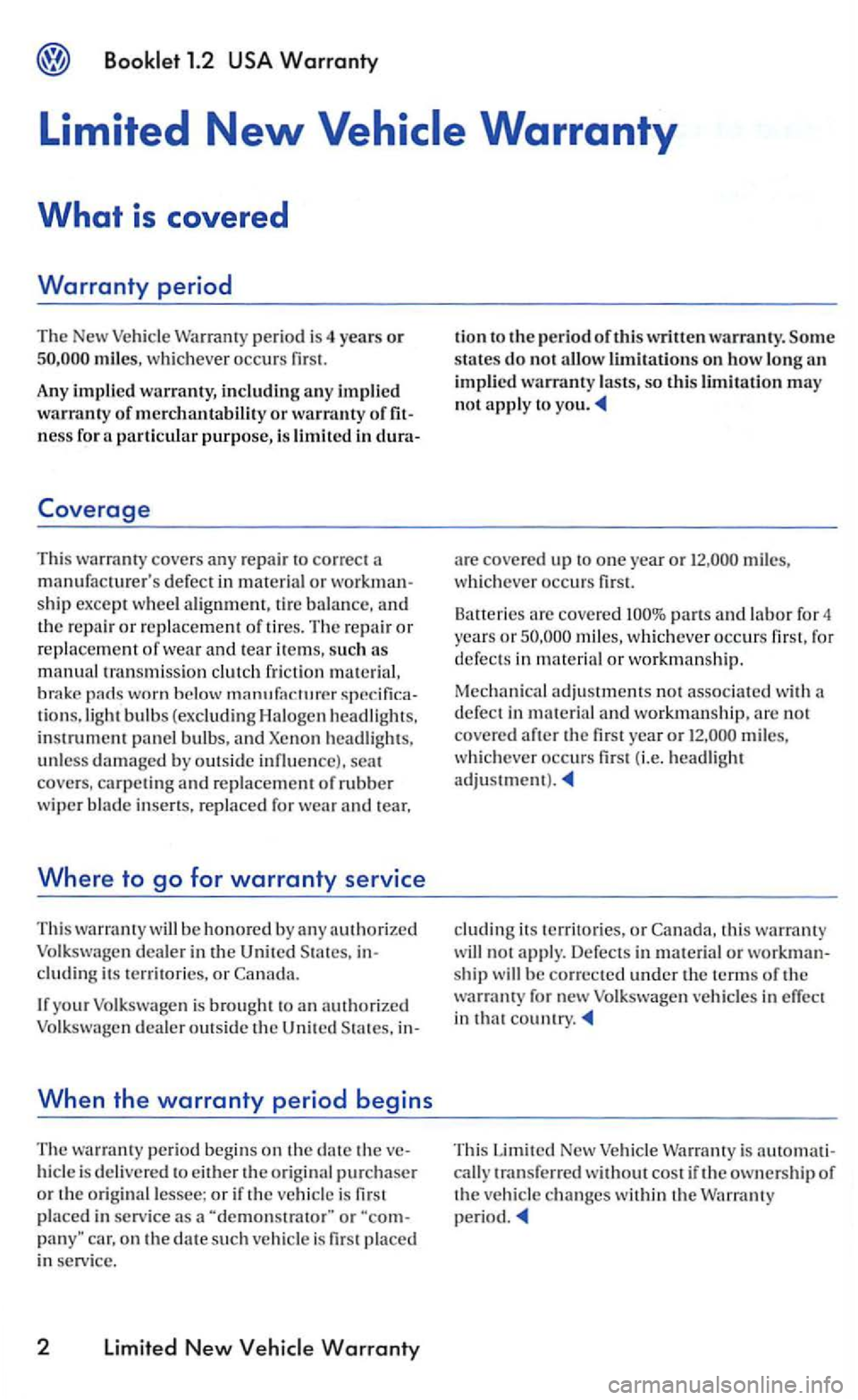
miles, w hichever occurs
Thi s war ranty covers any re p air to correc t a
m anufacturer' s defect in mate ria l o r wo rk m an
s h ip except wheel alignment, tir e bala nce, and the re p air or re placem ent of tir es. The re p a ir or
r e p la c e m ent of wear and tear ite m s, such as m anual transmiss ion clutch frictio n m ate rial ,
tions. lig ht bul bs (excluding Halogen headli ghts.
instrument pan el bul bs,
be honored b y an y autho rized Volkswagen dealer in th e Un ited States, inclu din g its terr itori es, or Ca nada.
dealer outs id e th e Un ited Sta tes.
When the warranty period begins
The wa rranty period begin s on th e da te the hide is delivere d to eit her th e origina l purc haser
o r th e origin al lessee; or if th e ve hicle is fir s t
placed in serv ice as a pa ny" car, o n the date s uch ve hicle is firs t place d
in service.
2 Limited New
are covered up to one yea r or mil es,
w hi chever occurs
parts and labor fo r 4 yea rs or
m iles.
w hi chever occurs fir st (i.e. headli ght
eluding its territories, or Canad a. thi s will not apply. Defects in material or workmanship will be correcte d unde r the te rm s of the
warranty for new Volkswage n \'Chi cles in in t hat
Thi s Limited New Vehicle Warr ant y is
Page 237 of 444
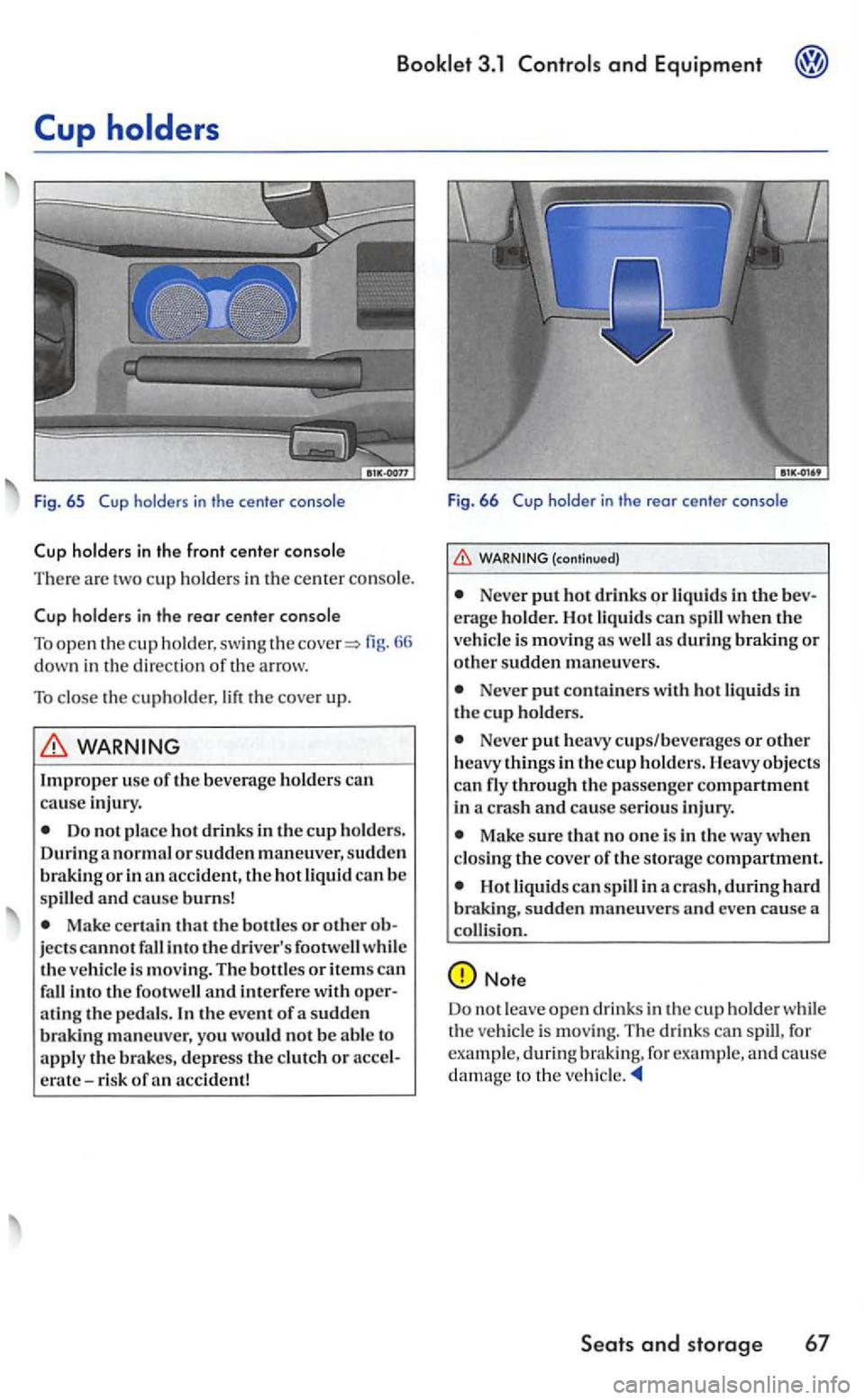
Booklet 3.1 Controls and Equipment
Fig . 6 5 holder s in the center console
66 down in th e dir ection of th e arrow.
To close the cupholder, lift the cove r up.
WARNING
Improper use of the be verage holders can
caus e injury .
Do not place hot drinks in the cup holders.
During a normal or sudden maneuver, s udd en
brakin g or in an accident , th e hot liquid can b e
s p ill ed and ca use burns!
Make certain that the bottles or other ject s cannot fall into tl1e driver 's footw ell whil e the vehicle is moving . The bottles or items can fall into the footwell and interfere with ating the ped als. In the event of a sudden
braking maneuve r, you would not be ab le to
apply the brakes, depres s the clutch or
(con tinued)
Neve r put hot drinks or liquid s in the era ge holder. Hot liquid s can spill when the
ve hicl e is moving as well as during brakin g or other sudden maneuver s.
Never put contai ners witl1 hot liquid s in
th e cup hold ers.
Neve r put heavy cups /b everages or ot her
h eavy things in the cup holders. Heavy objects
ca n fly through the passe nger compartment in a cra sh and cause serio us injury.
Make sure d1at no one is in the way when closing the cover of the storage compartment.
Hot liquid s ca n spill in a crash, during hard
Page 255 of 444
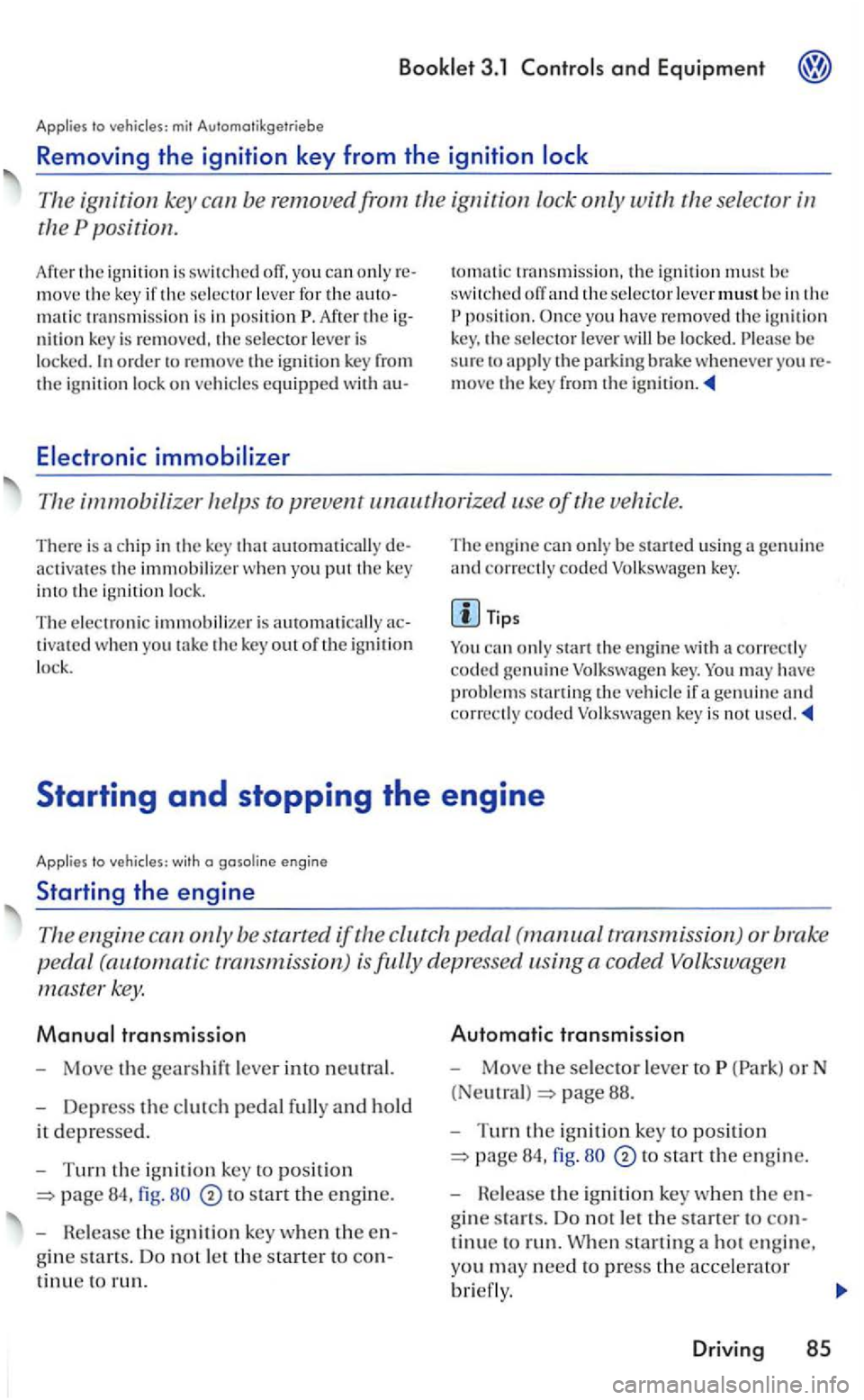
Booklet 3.1 and Equipment
Applies to
The ig nition key be removed from the ignition lock only with the selector
th e position.
Afte r th e ignition is sw itch ed move the key if the selecto r lever for the ma tic tran smissio n is in pos ition P . Afte r th e nitio n key is removed , th e sele ctor lever i s
l ocked. order to remove the ignition key from
the ig n it ion lock on vehicles equipped with
tomati c transm iss io n. the ig nition must switched off an d th e selecto r lever mus t b e in the posit ion . O nce you have rem ove d th e ig ni tio n
key. the sel ector lever be locke d. be
s ure to ap ply th e park ing brake whenever you move the key from the
immobilizer help s to prevent
ac tivates the immobilizer w hen you put the key into the ignition lock .
The e lec troni c immobilizer is automatica lly tivated when you the key out oft h e igni tion
l oc k. The
en gine
can only be started usin g key.
co rrect ly
code d genuine key . You may have prob le m s s tarting the vehicle if a genuine and
correc tly code d
with o gasoline engine
Starting the engine
only be started (manual transmission ) or brake
pedal
transmission. ) is fully depressed using a coded Volkswag en
maste r key.
Manual transmiss ion
-Move th e gearshif t leve r into neutral.
- Depress the clutch p edal full y and hold
it d epressed.
-Turn th e ign itio n key to position
page 84, fig. to start the e n gin e.
- Rel
ease th e ig nition key when the
gin e starts. Do not le t th e starter to
tinue to run.
Automatic transmissio n
Move the selector lever toP
page 88.
-
Turn th e ignition key to position
fig . start th e en g in e.
-
the ignition key when the
tinue to run. When starting a hot en g in e.
yo u
need to press th e accelerator
briefly .
Driv ing 85
Page 261 of 444
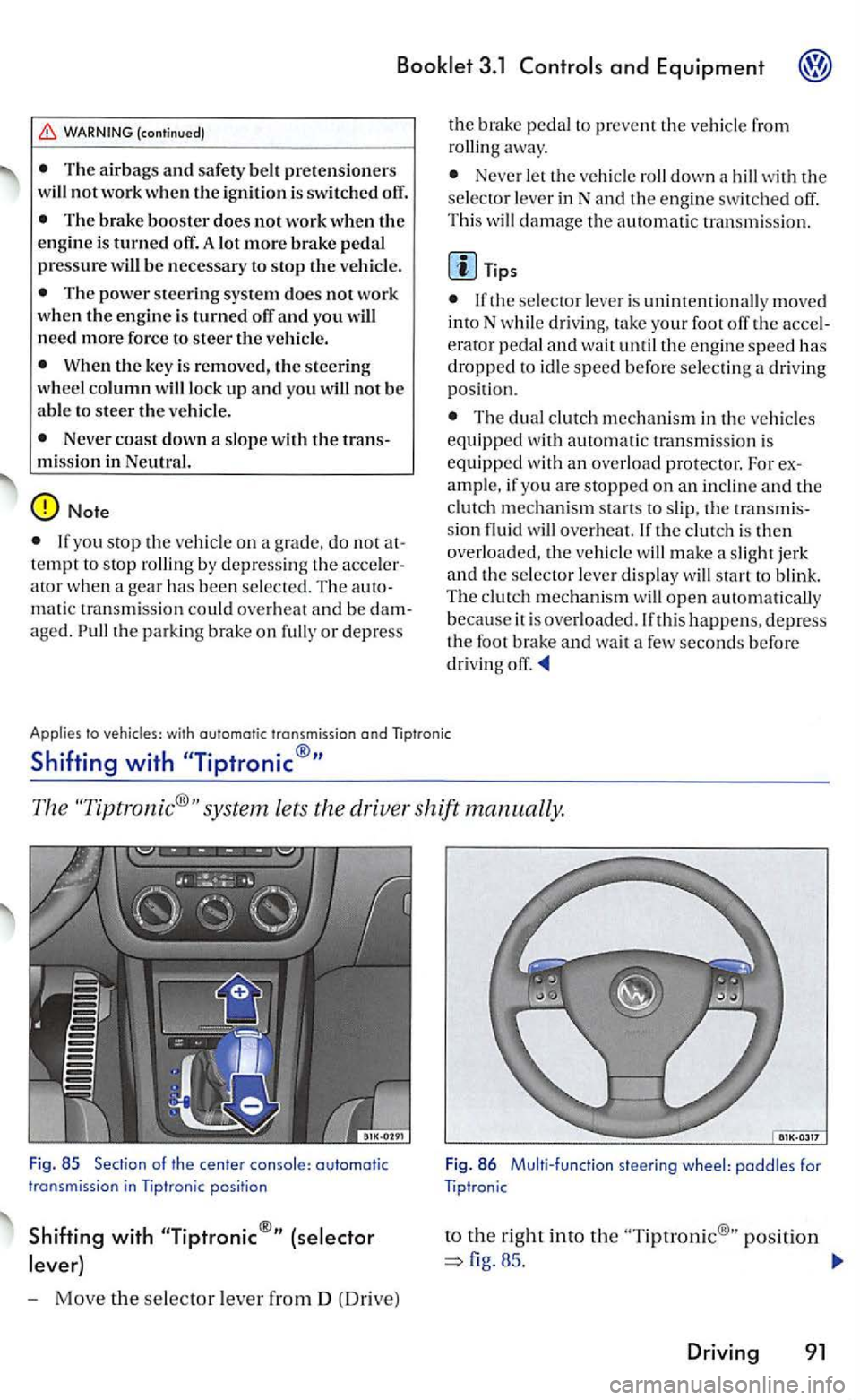
3.1
WARNING (continued)
T he air bags and safe ty be lt pre te n sio ners
will not work w he n the ign ition is switch ed off.
Th e brake booster does not work when the e ngine is turned off. A lot more brak e pedal pressu re w ill be necessary to stop the vehicle.
The power steering syste m does not work
w hen the e ngine is turned off and you will need more force to steer the ve hicl e.
When the key is removed, the s teering wheel column will lock up a n d yo u will not be able to steer the veh icle.
Neve r coast down a s lope with the tran smission in Neutral.
Note
If you stop th e ve hicle on a grade , d o not attempt to stop rolling by depres sin g th e acce le rator w hen a gea r has been se le ct ed. The automatic tra nsmi ssion could overhea t and be dam
a ge d. Pull the parkin g brake on full y or depress t
h e
brake ped al to prevent th e ve hicle from
ro llin g away.
Neve r le t the ve hicl e roll down a hill with the se lector le ver inN and the engine swit ched off .
Thi s will damage the automatic tran smission.
Tip s
lfthe sele cto r le ver is un int en tio nally m oved
int o N while driving , take your foot off the accel
era to r pedal and wa it until the engin e speed has dropped to idle sp eed b efore selec tin g a driv ing position.
The dual clut ch mechanism in the vehicl es
e quipped with au tomatic tra nsmis s io n is
equip ped with an overload pro tector. For ex
ample, if yo u are stopped on a n inclin e and the
clutch mechanis m sta rts to slip, th e transmi s
s ion fluid will ove rheat. th e clutch is then overload ed, the vehicle will m ake a slight jerk and th e s elector leve r d is play will start to blink.
T he clut ch m echanism will op en auto mati cally
because it i s o verloaded .lf th is happe n s, d epress the foot brake and wait a few se conds before
dri ving off.
Applies lo veh icles: w ith automol ic tr ansmission and
Shifting with
The system lets th e driver shift manually.
Fig. 85 of
- Move the sele c tor leve r from D (Dr iv e)
F ig . 86 Multi-function steering wheel: paddles for
to the right into the po sition
85 .
Driving 91
Page 267 of 444
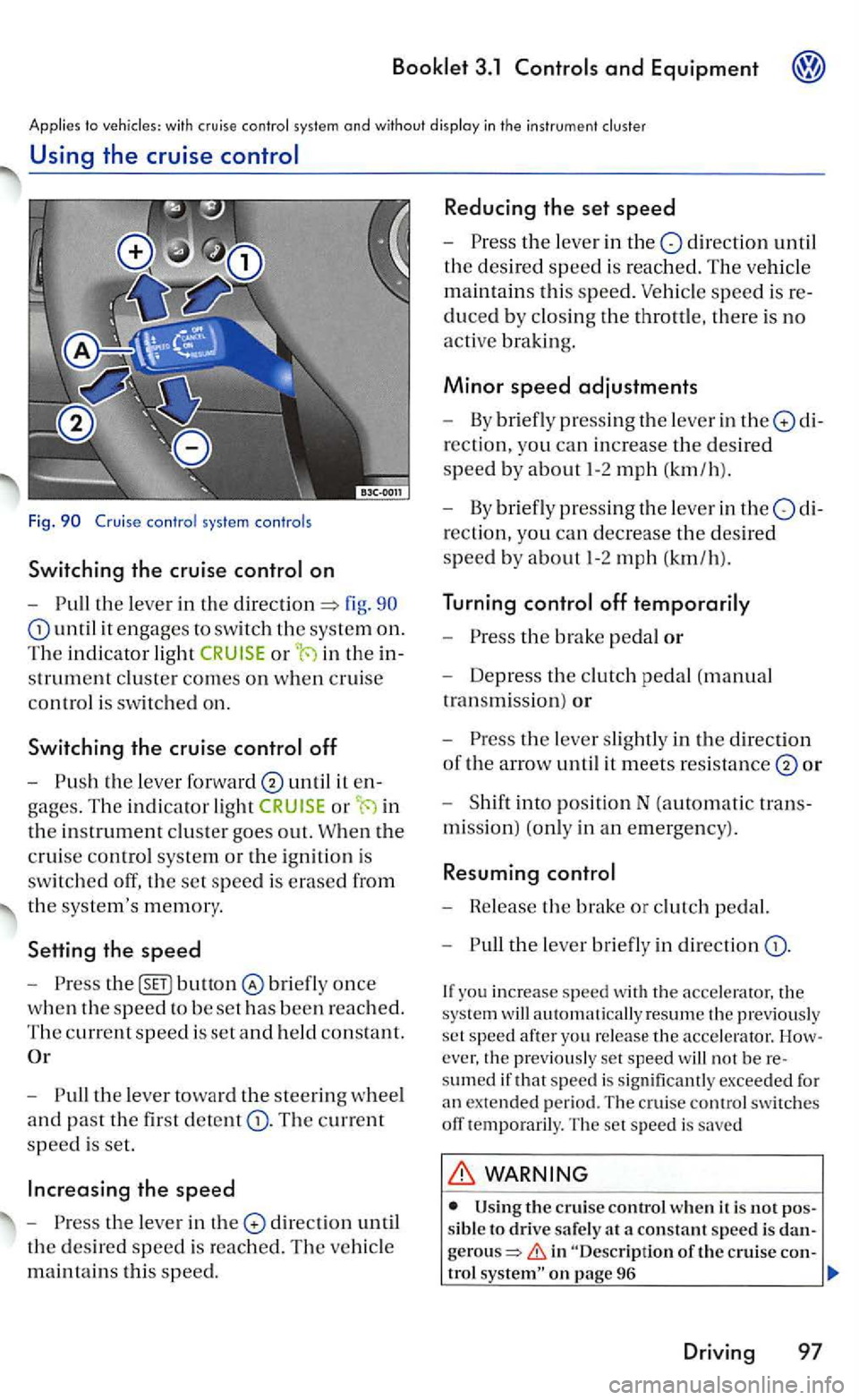
3.1
Applies to w ith cruise control system and without display in th e instrument cluste r
Using the cruise
Fig.
on
- Pull the le ve r in the fig. 90
until it engages to switch the system on.
The in dicato r light in the
strument cluste r comes on w he n cruise
co ntrol is switche d on.
Switching the cruise
until it
or in
the in strument clu ste r goes out. W hen the
c rui
se control syste m or the ig niti on i s
sw itch
ed off , th e set speed is erased from
t h e syste
m's m em ory.
Setting the speed
- Press bunon once
w hen th e s peed to be se t has been reached .
The current sp ee d is set and h eld co nsta nt.
- Pull the leve r toward the steerin g w heel
and past the fir st d etent The current
speed is set.
directio n until
the desir e d speed is reac hed. The ve hicl e
m ain tain s thi s spee d.
Reducing the set speed
- Press the leve r in the dir ectio n until
th e desired speed is reached. T he ve hicle
m aint a
ins thi s s pee d. Vehicle speed is
duced b y clos in g th e throttle, there is no
acti ve bra king .
Minor speed adjustments
-By briefl y press ing the leve r in the
rection, yo u can increase th e des ired
speed b y about 1-2 mph (km /h ).
- By briefl y
pressing the leve r in the
-Press the brake pedal or
-Depress the clutch pedal (manual
tran smi ssi
on) or
- Press the leve r slightl y in the direction
of the arrow un til it m ee ts resis tance or
- Shift into posit io n N (automatic
mi ssion) (only in an em erge ncy).
Resuming
- Release th e brake or clutc h pedal.
- Pull
the le ve r briefly in direction
ever, the previou sly set speed will not be sumed if that s peed is s ignificantl y exce ed ed fo r
a n extended perio d. The cruise cont rol switc hes off tempo raril y. The set s p ee d i s saved
WARNING
sibl e to drive safe ly at a constant speed i s gerou s=> in "Desc ription of the crui se con-trol
Driving 97